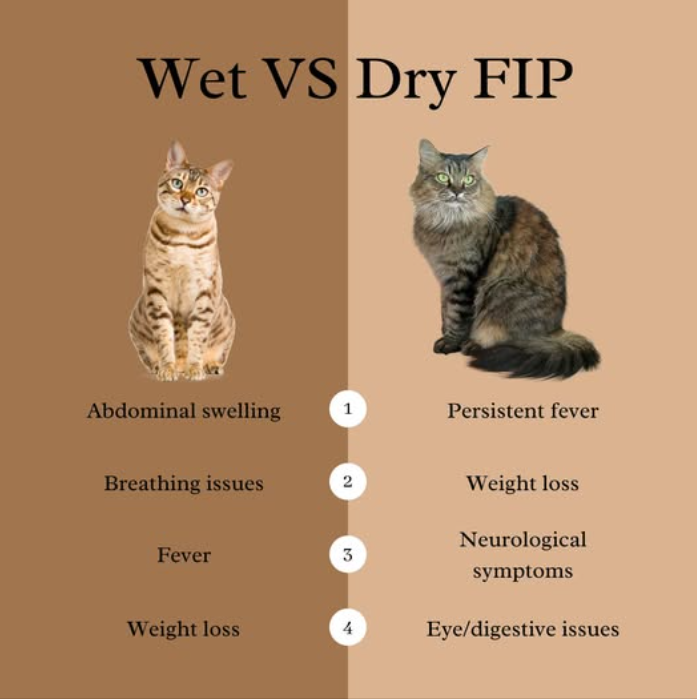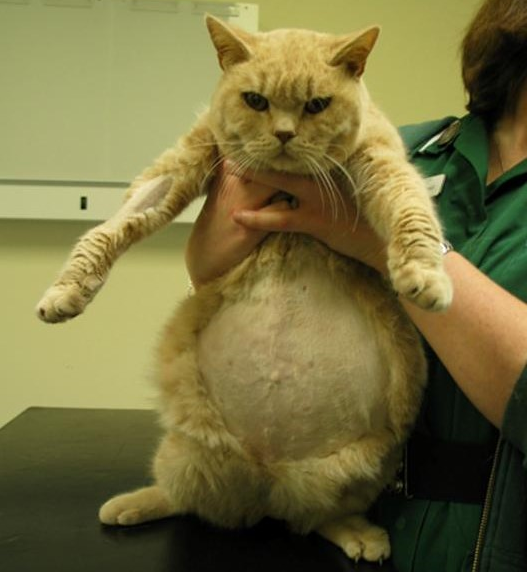Description of symptoms of feline infectious peritonitis
Feline Infectious Peritonitis (FIP) presents with diverse symptoms depending on the form—wet (effusive) or dry (non-effusive)—and the affected organs. Below is a detailed breakdown of typical symptoms, diagnostic clues, and key differentiators:
I. Common Initial Symptoms (Both Forms)
- Non-specific Signs:
- Persistent Fever: 39.5–41°C (103–106°F), unresponsive to antibiotics.
- Weight Loss: Progressive despite normal or reduced appetite.
- Lethargy: Reduced activity, prolonged resting, or hiding.
- Anorexia: Partial or complete loss of appetite, leading to malnutrition.
II. Wet Form (Effusive FIP): Characterized by Fluid Accumulation
1. Abdominal Effusion (Ascites):
- Distended Belly: Firm, painless swelling (palpable fluid wave in advanced cases).
- Respiratory Distress: Compression of diaphragm may cause rapid breathing (tachypnea) or open-mouth breathing.
- Gastrointestinal Signs: Vomiting, diarrhea, or constipation due to organ displacement.
2. Thoracic Effusion (Pleural Effusion):
- Severe Dyspnea: Difficulty breathing, shallow respirations, or refusal to lie down.
- Coughing: Rare, but may occur if fluid irritates the lungs.
3. Ocular and Systemic Signs:
- Icterus (Jaundice): Yellowing of gums, skin, or sclera due to liver involvement.
- Anemia: Pale mucous membranes from bone marrow suppression or chronic inflammation.

III. Dry Form (Non-effusive FIP): Characterized by Granulomatous Lesions
1. Ocular Involvement:
- Uveitis: Iris swelling, pupil irregularity, or greenish/yellow discharge.
- Retinal Lesions: White spots (chorioretinitis) or detachment, leading to vision loss.
- Conjunctivitis: Redness, tearing, or corneal opacity.
2. Neurological Symptoms:
- Ataxia: Loss of balance, wobbly gait, or limb weakness.
- Seizures: Sudden convulsions, muscle twitching, or loss of consciousness.
- Behavioral Changes: Disorientation, head pressing, or paralysis (e.g., hindlimb paresis).
- Facial Nerve Paralysis: Drooping jaw, inability to blink, or facial asymmetry.
3. Systemic Manifestations:
- Lymphadenopathy: Enlarged lymph nodes (e.g., submandibular or abdominal nodes).
- Organomegaly: Palpable liver or spleen enlargement due to granulomas.

IV. Advanced Symptoms (Both Forms)
- Severe Cachexia: Wasting of muscle mass, emaciation.
- Multiorgan Failure: Kidney dysfunction (polyuria, polydipsia) or liver damage (elevated enzymes).
- Disseminated Intravascular Coagulation (DIC): Bleeding disorders (nosebleeds, bruising).
V. Key Diagnostic Clues
| Symptom Category | Wet FIP Indicators | Dry FIP Indicators |
|---|---|---|
| Physical Exam | Abdominal/chest fluid, icterus | Enlarged lymph nodes, ocular lesions, neurological deficits |
| Lab Tests | Low albumin/globulin ratio (A/G < 0.6), elevated globulins | Anemia, thrombocytopenia, organ-specific enzyme elevations |
| Imaging | Ultrasonography shows ascites/pleural effusion | CT/MRI may reveal granulomas in brain/abdomen |
| Fluid Analysis | Yellow, protein-rich ascites (TP > 3.5 g/dL), high nucleated cell count | – |
VI. Differential Diagnoses (Common Mimics)
- Pyothorax/Abdominal Abscess: Fever, fluid accumulation, but responsive to antibiotics.
- Heart Disease: Dyspnea, ascites, but heart murmurs or arrhythmias present.
- Kidney/Liver Failure: Weight loss, anemia, but specific biomarker elevations (e.g., creatinine, bilirubin).
- Lymphoma: Lymphadenopathy, organomegaly, requires biopsy for confirmation.
VII. Clinical Course and Onset
- Acute vs. Chronic:
- Wet FIP: Symptoms progress over 2–4 weeks (rapid fluid accumulation).
- Dry FIP: Develops over months, with insidious neurological/ocular signs.
- Risk Factors: Young cats (<2 years), multi-cat households, stress-induced immune suppression.
VIII. Importance of Early Detection
- Critical Window: FIP is often misdiagnosed initially (e.g., as “stress” or “upper respiratory infection”).
- Diagnostic Steps:
- Comprehensive blood work (CBC, biochemistry, A/G ratio).
- Fluid analysis (if effusion exists).
- PCR for feline coronavirus in blood/effusion (not definitive, but supportive).
- Histopathology (biopsy of granulomas) for confirmatory diagnosis.
Note: Prompt veterinary evaluation is essential if persistent fever, weight loss, or organ-specific signs (e.g., neurological/ocular issues) are observed, especially in at-risk cats. Early initiation of antiviral therapy (e.g., GS-441524) significantly improves prognosis.

